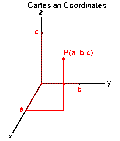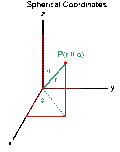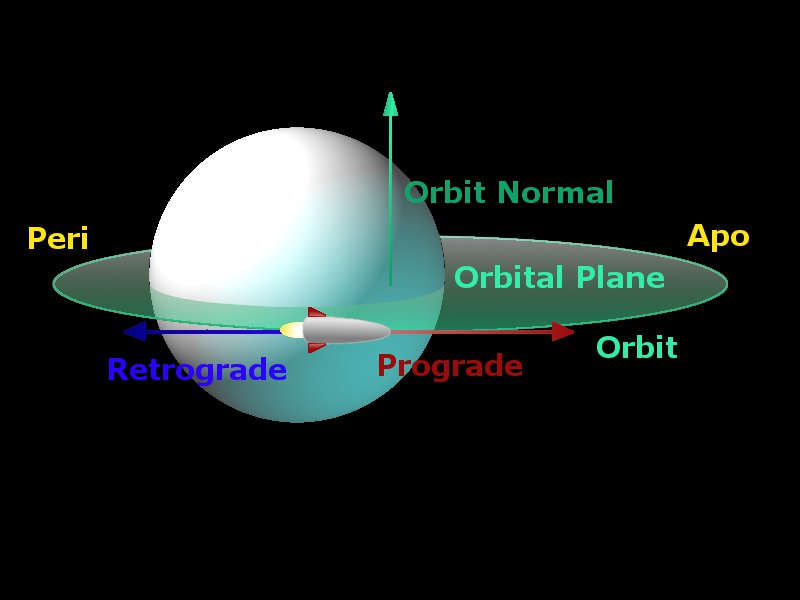Difference between revisions of "Terminology"
(→Mathematic & Geometric) |
(→Orbital Terms) |
||
| Line 55: | Line 55: | ||
|- | |- | ||
!Peri-* and Apo-* | !Peri-* and Apo-* | ||
| − | | When speaking of orbits, oftentimes you replace the "-apsis" of Periapsis and Apoapsis with something signifying which planet you are speaking of | + | | When speaking of orbits, oftentimes you replace the "-apsis" of Periapsis and Apoapsis with something signifying which planet you are speaking of. In this game, -kee and -kerb are both commonly used to describe orbits around Kerbin resulting Perikee/Perikerb and Apokee/Apokerb. |
|- | |- | ||
!Ascending Node | !Ascending Node | ||
| Line 64: | Line 64: | ||
|- | |- | ||
!Eccentricity | !Eccentricity | ||
| − | | A scalar describing how non-circular an orbit is. | + | | A scalar describing how non-circular an orbit is. |
| − | + | * ecc = 0 → circular orbit. | |
| − | + | * 0 < ecc < 1 → elliptical orbit. | |
| − | + | * ecc = 1 → parabolic orbit - this is an escape orbit. | |
| − | + | * ecc > 1 → hyperbolic orbit - this is an escape orbit. | |
| − | |||
| − | |||
| − | |||
| − | |||
| − | |||
|- | |- | ||
!Inclination | !Inclination | ||
| Line 107: | Line 102: | ||
|- | |- | ||
!Semi-major axis | !Semi-major axis | ||
| − | | The major-axis is the long axis of an ellipse, and the semi-major axis is half of this. In KSP the semi-major axis is calculated with sma = | + | | The major-axis is the long axis of an ellipse, and the semi-major axis is half of this. In KSP the semi-major axis is calculated with <tt>sma = radius + (Ap + Pe)/2</tt>. It's the average of the Apoapsis and Periapsis computed relative to the center of the body. As both are relative to the bodies surface, the radius must be added. All orbits with the same semi-major axis have the same period, regardless of their eccentricity. |
|- | |- | ||
!Sub-Orbital | !Sub-Orbital | ||
Revision as of 10:29, 5 March 2013
In KSP, there are many terms pertaining to orbiting and physics that often can be confusing to non-technicians. In addition, various other scientific terms and abbreviations are used to describe common terms.
This sheet is designed as a concise lookup table of necessary terms to help you get started down the road to being a full fledged astronaut!
Contents
Helpful Terms
Mathematic & Geometric
| Term | Explanation |
|---|---|
| Elliptical | Oval shaped, often in reference to your orbit. |
| Normal vector | A vector perpendicular to a plane. |
| Scalar | A single value without a direction. Scalars are usually followed by a unit of measurement that tells what the scalar's dimension is. eg 3 m/s, 3 m,3 s are scalar: they have units which denote speed, length/distance, and time respectively, but have no direction. |
| Vector | A set of a direction and a value. eg. heading (direction) and speed together give a velocity.
How a vector is expressed depends on what the coordinate system is, and how many dimensions are taken into consideration. <35°, 12> is a two dimensional polar vector, where <14, 9, -20> is a three dimensional Cartesian vector. There are other coordinate systems but these are the most utilized. <35°, 12> looks like an arrow which is 12 units long, starting from the origin (zero, angle does not matter because it is a point with no length) and ending at a point 35° from the base axis (typically the x-axis, positive angles progress counter-clockwise) <14, 9, -20> looks like an arrow starting from the origin (<0,0,0>) and ending at a point where the x coordinate is at 14, the y coordinate = 9 and the z coordinate = -20. The upside to using Cartesian coordinates is that you know exactly where the terminal position is, but it is more difficult to figure the length, however in polar coordinates it is trivial to find the length, the downside is its more difficult to know the position.
|
A 3D coordinate systems needs:
- A point of reference. This is your origin.
- 3 base-vectors. These define your base unit of measurement along the axis and the direction of said axis.
- A mix of 3 scalars, that could be either angles or co-ordinates to express locations in your co-ordinate space.
Orbital Terms
| Term | Explanation |
|---|---|
| Apoapsis | In an elliptical orbit, the point of the orbit farthest from the planet. |
| Periapsis | In an elliptical orbit, the point of the orbit closest to the planet. |
| Peri-* and Apo-* | When speaking of orbits, oftentimes you replace the "-apsis" of Periapsis and Apoapsis with something signifying which planet you are speaking of. In this game, -kee and -kerb are both commonly used to describe orbits around Kerbin resulting Perikee/Perikerb and Apokee/Apokerb. |
| Ascending Node | The point at which the orbit crosses the reference plane moving north. Here, "north" means the direction of the orbit normal of the reference plane. |
| Descending Node | The point at which the orbit crosses the reference plane moving south. |
| Eccentricity | A scalar describing how non-circular an orbit is.
|
| Inclination | The angle between an orbital plane relative to a reference plane (e.g. an orbit with 90° inclination to an equatorial reference plane would be called polar). |
| Low Kerbin Orbit | Also known merely as LKO. A "low orbit" exists for most planetoids with a gravity well. It describes an orbit that is low, but stable (above atmosphere). Low orbits are used as stepstones, after ascent and before burning to another rendezvous object (planet/vessel), as it allows to perform the exit burn at any point of the orbit. The upside is that it requires the least possible amount of fuel to reach a low orbit. |
| Zenith | "Up" in ground-relative coordinates, i.e. the direction your rocket points at when at the launchpad, aka: "the highest point in the sky". |
| Nadir | opposite direction of "Zenith". |
| Orbital Nodes | Specific points of reference in any orbit such as Apoapsis, Periapsis, intersect points with other orbits etc. |
| Orbit Normal | A normal vector of the Orbital Plane. Produced by cross multiplying the ship's velocity and gravity. Since this follows the right hand rule, from a perspective where the ship is orbiting counter-clockwise it will point "up", while for a ship orbiting "clockwise" it will point down. "Up" is also often labeled as "North" or "N+", and in tandem with that "Down" is labeled "Anti-Normal", "South" or "N-". |
| Orbital Plane | The imaginary disk described by the path of an orbit around a body (commonly used when describing inclinations). |
| Prograde | The "Direct" direction of your orbital path. Since orbits are elliptical, it's actually the tangent of the orbit where the ship is. |
| Retrograde | The reverse of Prograde, "backwards". |
| Reference Plane | Any plane used as a reference for describing your current orbit. For local orbits around a planet, this is often the equatorial plane. When multiple bodies in a solar system are involved, the ecliptic plane can be used. For intercepting another orbiting body, the orbital plane of the body to be intercepted is used. An orbital plane can be fully described by giving the inclination and the longitude of the ascending node relative to a reference plane. |
| Semi-major axis | The major-axis is the long axis of an ellipse, and the semi-major axis is half of this. In KSP the semi-major axis is calculated with sma = radius + (Ap + Pe)/2. It's the average of the Apoapsis and Periapsis computed relative to the center of the body. As both are relative to the bodies surface, the radius must be added. All orbits with the same semi-major axis have the same period, regardless of their eccentricity. |
| Sub-Orbital | Describes an orbit where the periapsis is below the surface of a planetary body, leading to an impact on said body. |
| Thrust-Weight-Ratio | TWR in short. The Ratio between the total mass of the vehicle and the available thrust of all propulsion devices of the vehicle. TWR > 1 means you will be have enough thrust to actually ascend. A TWR below 1 means you will not be able to counteract gravity and drag at low altitudes (though a low TWR might totally suffice in space). |
A quick picture to help with some of the explanation:
Space Maneuvers
| Term | Explanation |
|---|---|
| Atmospheric Braking | Lowering the periapsis so it is inside a planetary atmosphere. This will lead to the vessel being slowed by atmospheric drag. Can lead to reentry (see below), but also is used to reduce the necessary burn time for significant orbit alterations. |
| Burn | firing of the engines, usually to alter trajectory in some way. |
| Circularizing | a maneuver (firing of the engines) that makes an orbit circular. This is usually achieved by a burn close to Apoapsis. |
| Re-entry | Re-entering atmosphere and using drag to decelerate a vessel to a groundwards trajectory. This usually causes intense heat stress on the object as the vessel requires sufficient speed to not "bounce" back from the atmosphere into space. Currently atmospheric heat and the "bounce" are not implemented in KSP (there are mods, however). |
| Retroburn | A burn performed "backwards", e.g. with the engines facing towards prograde and nose towards retrogade (hence the name). This is a common maneuver to used to lower the height of the orbit without altering any other orbital parameters. |
Physics
| Term | Explanation |
|---|---|
| Acceleration | Rate of change to your velocity. Acceleration is a vector, measured in "m/s2". |
| Ballistic trajectory | A falling object's trajectory is ballistic. In rocketry it usually indicates that the object in question is only influenced by gravity and does not exert any force (ie. thrust) of its own. |
| Delta-v (Δv) | The change in velocity that has or can be exerted by your spacecraft. This is measured in meters per second (m/s). More mass can reduce the delta-v, while more propulsion can increase it. This makes it a useful value to calculate efficiency of launch vehicles. For example, a launch vehicle requires about 4,000 m/s of delta-v to escape Kerbin's atmosphere and achieve a stable orbit. |
| Energy | The energy of an object in an orbit is the sum of its potential and kinetic energy. Potential energy is Ep = - GMm/R and Kinetic Energy Ek = (1/2) m v2 where G is the gravitational constant, M is the mass of the planet, m is the mass of the vehicle, R is the distance from the center of the planet and v is the velocity. So E = (1/2) m v2 - GMm/R . When the energy is greater than zero the vehicle is on an escape trajectory. All orbits with the same semi-major axis have the same energy. |
| Escape Velocity | The velocity needed to escape a given planet's gravity well. |
| G | A measurement of force as expressed in the sea-level force of Earth's gravity. In other words, right now you're under 1 G. 2 G's is equivalent to twice earths gravity at sea level, and so on. |
| Gravity | The force exerted by all objects with mass. Very weak. Usually only objects with very high mass - ie. planets, moons - have any noticeable effect. Diminishes with the square of distance from the center of mass. So for an object twice as far, experiences only 1/22 = 1/4 of the gravity. |
| Gravity Well | The area around a planet affected by gravity. Actually extends to infinity, but as gravity decreases exponentially with distance, it is only significant within the planet's sphere of influence. |
| Orbit | When an object has sufficient tangential velocity (and is outside the atmosphere, so drag won't slow it down) so that it will keep falling "next" to the planet (never touching ground) its trajectory is called an orbit.
Stable orbits are elliptical (a circle is an ellipse with zero eccentricity).
|
| Sphere of influence | The radius around a celestial body where its gravity well is non-neglectable. Commonly known as SoI/SOI. |
| Tangential velocity | The component of your velocity that's perpendicular to your trajectory. Instantaneous velocity - velocity when the time of measurement approaches zero - is always tangential to your trajectory. |
| Trajectory | A trajectory is the path that a moving object follows through space as a function of time. |
| Velocity | Rate of change of your position. Your speed and direction. Velocity is a vector, measured in meters per second (m/s). |


